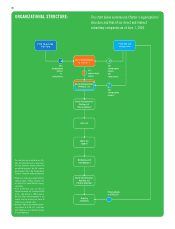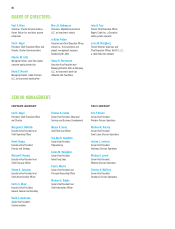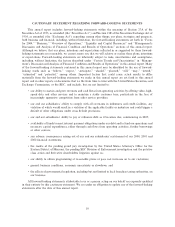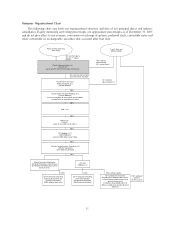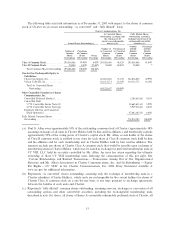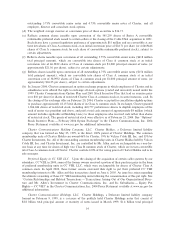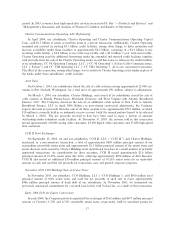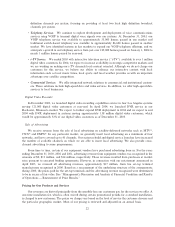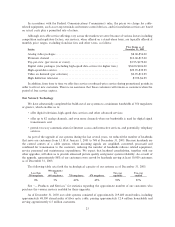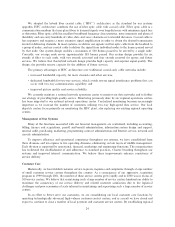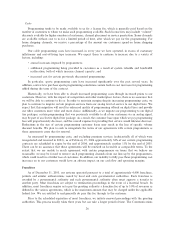Charter 2003 Annual Report Download - page 18
Download and view the complete annual report
Please find page 18 of the 2003 Charter annual report below. You can navigate through the pages in the report by either clicking on the pages listed below, or by using the keyword search tool below to find specific information within the annual report.OUR BUSINESS
Introduction
Charter Communications, Inc. (""Charter'') is a broadband communications company operating in the
United States, with approximately 12.4 million homes passed and approximately 6.54 million customers at
December 31, 2003. Through our broadband network of coaxial and Ñber optic cable, we oÅer our customers
traditional cable video programming (analog and digital, which we refer to as ""video'' service), high-speed
cable Internet access (which we refer to as ""high-speed data service''), advanced broadband cable services
(such as video on demand (""VOD''), high deÑnition television service and interactive television) and, in some
of our markets, we oÅer telephone service (which we refer to as ""telephony''). (""Homes passed'' represents
our estimate of the number of living units, such as single family homes, apartment units and condominium
units passed by our cable distribution network. Homes passed excludes commercial units passed by the cable
distribution network.)
We oÅer analog video service to all of our homes passed and we oÅer digital video service to
approximately 99% of our homes passed. At December 31, 2003, we served approximately 6.43 million analog
video customers, of which approximately 2.67 million are also digital video customers. We oÅer high-speed
data service to approximately 87% of our homes passed and we serve approximately 1.57 million high-speed
data customers (including approximately 105,800 who receive high-speed data only services). At Decem-
ber 31, 2003, we oÅered voice-over-Internet protocol (""VOIP'') telephony to approximately 33,000 homes
passed in one market and traditional switch-based telephony to approximately 86,600 homes passed in another
market. We provided telephony service to approximately 24,900 customers in these two markets as of that
date. See ""Ì Products and Services.''
Certain SigniÑcant Developments in 2003 and Early 2004
In 2003, we substantially completed the upgrade of our cable systems that we had commenced in 2000.
Our systems upgrade increased our bandwidth capacity, enabling us to oÅer digital video service, two-way
communication capability and other advanced services. In addition, our upgrade has enabled us to reduce the
number of headend control centers, or ""headends,'' which house the equipment to receive broadcast and
satellite signals, transmit signals to customers and connect customers for data services. In 2003, we invested
approximately $132 million to upgrade our systems. At December 31, 2003, approximately 92% of our
customers were served by bandwidth of 550 megahertz or greater, approximately 87% are served by bandwidth
of 750 megahertz or greater and approximately 87% of our plant was two-way enabled. See ""Ì Our Network
Technology.''
During 2003, we undertook a number of transition activities including reorganizing our workforce,
adjusting our video pricing and packages, completing call center consolidations and implementing billing
conversions. Due to the focus on such activities and certain Ñnancial constraints, we reduced spending on
marketing our products and services. We believe that the reduction in marketing activities and other necessary
operational changes negatively impacted customer retention and acquisition, primarily during the Ñrst half of
the year. During the second half of 2003, we increased our marketing eÅorts and implemented promotional
campaigns to slow the loss of analog video customers, and to accelerate advanced services penetration,
speciÑcally in high-speed data. In 2003, we had a net decline in analog video customers from approximately
6.58 million to approximately 6.41 million. During the same period, our number of high-speed data customers
increased by approximately 427,500, contributing to a revenue increase of approximately 6% in 2003. See
""Management's Discussion and Analysis of Financial Condition and Results of Operations.''
At December 31, 2003, we oÅered digital video service to approximately 99% of our estimated homes
passed and the estimated penetration rate (i.e., the percentage of digital-enabled estimated homes passed that
received the service) was 22%. We also oÅered high-speed data service to approximately 923,500 additional
homes passed in 2003, bringing estimated high-speed data enabled homes passed at December 31, 2003, to
approximately 10.7 million, and increased our number of high-speed data customers during 2003 from
approximately 1,138,100 to approximately 1,565,600, a penetration rate of 15% of high-speed data homes
16


